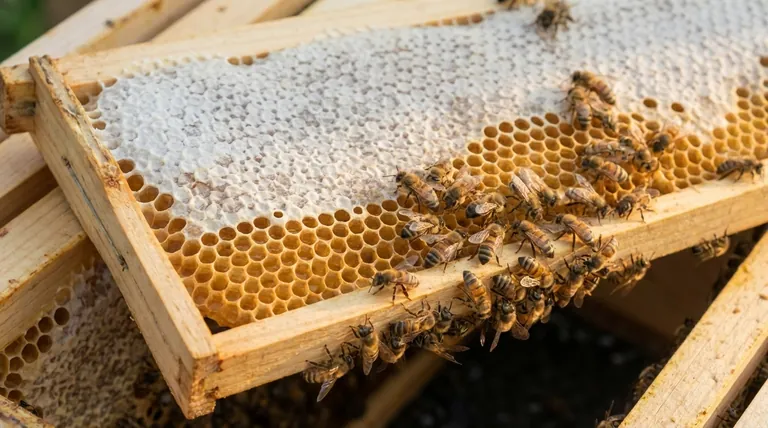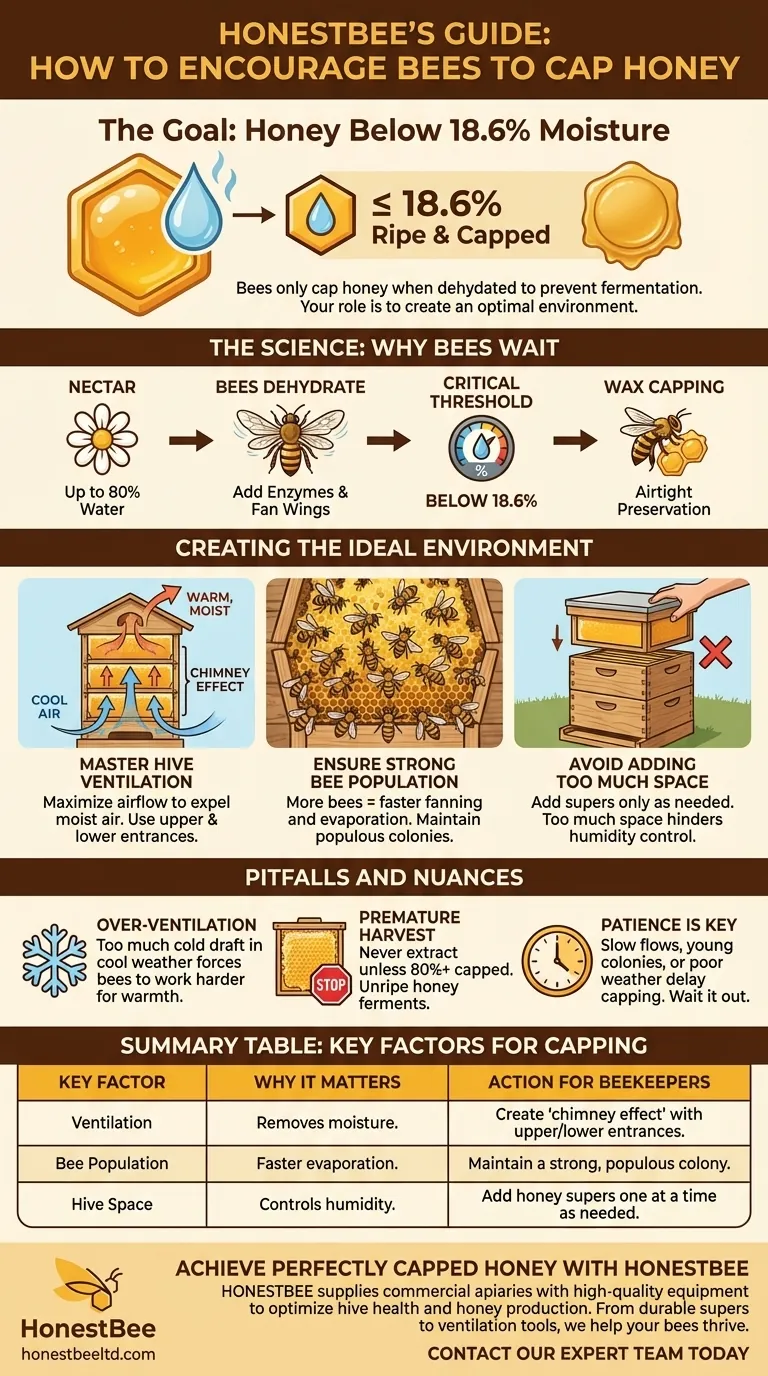To encourage bees to cap honey, you must help them reduce the nectar's moisture content to below 18.6%. Bees will only seal a cell once the honey is "ripe" and properly dehydrated to prevent fermentation. The most effective way a beekeeper can assist this natural process is by ensuring the hive has excellent ventilation to help carry away warm, moist air.
Bees will not cap honey until it is sufficiently dehydrated. Your role is not to force the process, but to create an optimal hive environment, primarily through managing airflow and space, that allows the colony to work efficiently.

The Science of Capping: Why Bees Wait
Before you can help the process, you must understand the bees' objective. Capping is the final step in a brilliant natural food preservation strategy.
From Nectar to Honey
Nectar collected from flowers can have a water content of up to 80%. This is far too high for long-term storage, as it would quickly ferment and spoil.
Bees begin the dehydration process immediately by adding enzymes and passing the nectar from bee to bee.
The Critical Moisture Threshold
Bees instinctively know that honey is only stable for long-term storage when its moisture content is below 18.6%.
Once the honey in a cell reaches this level, worker bees secrete beeswax from special glands and construct an airtight wax cap over the cell, preserving it indefinitely.
The Role of Bee Behavior
To remove the final amount of moisture, bees actively manage their environment. They fan their wings at the hive entrance and throughout the hive to create constant airflow, essentially evaporating the excess water from the uncapped cells.
Creating the Ideal Environment for Capping
Your job is to make the bees' work as easy as possible. You can directly influence the two most important factors: airflow and colony density.
Master Hive Ventilation
Proper airflow is the single most important factor you can control. Stagnant, humid air inside the hive makes it much harder for bees to dehydrate nectar.
The most effective method is to create a "chimney effect." Ensure you have both a standard lower entrance and an upper entrance or vent. This allows cool, dry air to enter from the bottom, while warm, moisture-laden air naturally rises and exits through the top.
Ensure a Strong Bee Population
A large, populous colony has a massive workforce. More bees means more fanning, which accelerates the evaporation process significantly.
A weak or small colony will simply take much longer to ripen and cap the same amount of honey because it has fewer workers available for the task.
Avoid Adding Too Much Space
While it's important to give bees room to store honey, adding too many empty honey supers at once can be counterproductive.
This spreads the colony too thin, making it difficult for them to control the temperature and humidity in the vast, empty space. Add supers one at a time as they are needed.
Understanding the Pitfalls and Nuances
Intervening without understanding the context can sometimes slow the process down.
The Risk of Over-Ventilation
While ventilation is key, too much airflow during cool or cold weather can be a problem. It can force the bees to work harder to maintain the necessary hive temperature (around 95°F / 35°C).
Balance is essential. In hot, humid conditions, maximize ventilation. In cooler weather, ensure the colony is not struggling against a constant draft.
The Dangers of a Premature Harvest
Never extract honey from frames that are not at least 80% capped. Unripe, uncapped honey has a high moisture content and will ferment in storage, spoiling your entire harvest.
Trust the bees. They are the ultimate quality control experts.
Patience Is a Primary Tool
Sometimes, there is no underlying problem. A slow nectar flow, a young colony, or a period of poor weather can all result in a slower capping process. Often, the best action is simply to wait.
Making the Right Choice for Your Hive
Apply these principles based on your specific hive's condition.
- If your hive is strong and the weather is warm and humid: Your primary focus should be maximizing ventilation with an upper entrance to help the bees expel moist air.
- If your frames are full of nectar but remain uncapped: Ensure the bee-to-space ratio is high by removing any excess empty supers to concentrate their efforts.
- If your colony is small or the weather is cool: Be more conservative with ventilation, ensuring the bees can easily maintain proper hive temperature while still allowing for some air exchange.
Ultimately, facilitating honey capping is about understanding bee biology and becoming a partner in their natural process of preservation.
Summary Table:
| Key Factor | Why It Matters | Action for Beekeepers |
|---|---|---|
| Ventilation | Removes moisture from nectar; bees cap honey below 18.6% moisture. | Create a 'chimney effect' with upper and lower hive entrances. |
| Bee Population | More bees fan wings to evaporate water faster. | Maintain a strong, populous colony; avoid weak hives. |
| Hive Space | Too much space spreads bees thin, hindering humidity control. | Add honey supers one at a time as the colony needs them. |
Ready to achieve perfectly capped honey frames? HONESTBEE supplies commercial apiaries and beekeeping equipment distributors with the high-quality, wholesale-focused supplies needed to optimize hive health and honey production. From durable supers to advanced ventilation tools, our equipment helps you create the ideal environment for your bees to thrive. Contact our expert team today to discuss your apiary's specific needs and ensure your next harvest is a success.
Visual Guide

Related Products
- Stainless Steel Dual Blade Uncapping Plane
- Professional Extra-Wide Uncapping Fork with Bent Tines for Beekeeping
- Professional Wide Blade Honey Scraper for Beekeeping and Honey Processing
- Portable Uncapping Tank Holder Uncapping Bench for Beekeeping
- Professional Long-Handled Silicone Honey Scraper for Beekeeping
People Also Ask
- What is an uncapping knife? Choose the Right Tool for Your Beekeeping Scale
- How are honey frames prepared before extraction? Master the Hive-to-Honey-House Process
- What is an uncapping knife used for? A Guide to Efficient Honey Harvesting
- What is the overall recommendation for beginner beekeepers regarding uncapping tools? Master Your First Honey Harvest
- What tools are available for uncapping honey? A Guide to Choosing the Right Tool for Your Operation



















